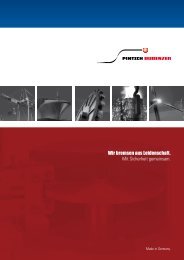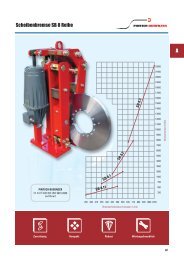SOS - PINTSCH BUBENZER GmbH
SOS - PINTSCH BUBENZER GmbH
SOS - PINTSCH BUBENZER GmbH
You also want an ePaper? Increase the reach of your titles
YUMPU automatically turns print PDFs into web optimized ePapers that Google loves.
S N A G O V E R L O A D SYSTEM
2<br />
Snag Overload System<br />
1 2
3<br />
Definition Snag Load Case<br />
• Sudden stopping of an empty or loaded spreader in a ship cell or other<br />
obstacle/barrier during the hoisting procedure of a crane.<br />
• Especially at high speed hoisting a sudden and extreme overload occurs.<br />
• Even a detection with conventional load cells does not provide stopping<br />
of the hoist fast enough due to slow PLC delays and motor inertia.<br />
Consequences<br />
1<br />
2<br />
3<br />
Broken ropes<br />
Broken gears<br />
or even worse<br />
3
4<br />
Snag Overload System<br />
1<br />
<strong>SOS</strong> Principle<br />
1. Motor<br />
2. Malmedie Safety Coupling MSC (see Malmedie catalogue)<br />
3. Malmedie Gear Coupling (see Malmedie catalogue)<br />
4. <strong>PINTSCH</strong> <strong>BUBENZER</strong> LiTec ® brake disc<br />
5. <strong>PINTSCH</strong> <strong>BUBENZER</strong> thruster disc brake SB28 with VSR unit<br />
(see data sheet A04)<br />
6. <strong>PINTSCH</strong> <strong>BUBENZER</strong> emergency brake SF with CMB unit –<br />
fast setting execution (see data sheet B03)<br />
7. <strong>PINTSCH</strong> <strong>BUBENZER</strong> <strong>SOS</strong> PLC<br />
8. Malmedie Drum Coupling TTX (see Malmedie catalogue)<br />
9. <strong>PINTSCH</strong> <strong>BUBENZER</strong> power unit (see data sheet B04)
2<br />
Conventional Hydraulic System<br />
• A snag load case is detected by electronic load cells.<br />
• A PLC opens a hydraulic valve and large hydraulic cylinders move to give<br />
rope until the hoist is stopped.<br />
Disadvantage<br />
• High maintenance effort (Oil, vents, seals, cylinders etc.)<br />
• High weight and enormous space requirement-machinery on trolley<br />
hoists are barely able to provide enough space and load capacity.<br />
• Slow in reaction due to PLC and hydraulic system delay times.<br />
• Rope tension rises significantly before snag load detection is achieved.<br />
Conventional Hydraulic System<br />
1<br />
2<br />
View cylinders / rope guiding<br />
Hydraulic Station / Maintenance<br />
Mechanical <strong>SOS</strong> (Snag Overload System)<br />
In a Snag Load Case, a Malmedie Safety Coupling MSC instantly separates<br />
the motor drives and their high mass inertia from the gearbox. Safety brakes<br />
immediately catch the load and avoid a loss of rope. LiTec ® Operating brake<br />
discs reduce the drive inertia significantly.<br />
Advantage<br />
• The MSC reacts mechanically within 5ms in case of a snag load.<br />
• The actual maximum load is far less compared with hydraulic systems.<br />
• The system is installed inside the hoist.<br />
• The total system weight is only 500 kg.<br />
• Maintenance of only 3 hours per year required.<br />
• The system is easily applicable for retrofit.<br />
5
6<br />
Snag Overload System<br />
2 2<br />
1<br />
x1: 0,0 ms<br />
x2: 72,4 ms<br />
dX: 72,4 ms<br />
Y1: 3,903 mA<br />
y2: 18,452 mA<br />
dY: 14,548 mA<br />
A Snag Case<br />
B SF brake<br />
closed<br />
C 90% contact<br />
force SF brake
25,000<br />
20,000<br />
15,000<br />
10,000<br />
5,000 mA<br />
0,000<br />
-5,000<br />
-10,000<br />
-15,000<br />
-25,2 ms<br />
A<br />
B<br />
C<br />
Eingang B<br />
20 ms/Div<br />
3<br />
4<br />
5<br />
Snag Load Case<br />
• At a Snag Overload, safety elements of the MSC mechanically separate<br />
the motors from the drive without exceeding an adjustable maximum<br />
torque.<br />
• The remaining inertia of the drive is minimized by using LiTec ® brake<br />
discs.<br />
• Sensors detect the trip of the safety elements and an ultra fast PLC<br />
closes the safety brakes.<br />
• When the service brakes are closed, the safety brakes will be opened<br />
again. The rope drum is held by the service brakes only.<br />
• The crane operator can now let down the load by using the hoist master<br />
switch. A separate PLC partially opens the service brakes and lets glide<br />
the brake disc with controlled rpm.<br />
• Now a brief hoist inspection is obligatory to ensure that no damage has<br />
occured. Then the system is reset manually and the crane can be placed<br />
back into service. Inspection and resetting requires only 5-10 minutes.<br />
Scenario<br />
1<br />
2<br />
<strong>SOS</strong> PLC<br />
MSC Coupling with snag & RPM sensors<br />
MSC<br />
• The safety brakes start to give braking force 30 ms after the MSC trip.<br />
100 ms after the trip the hoist stands still!<br />
• Now the service brakes are activated.<br />
Scenario<br />
3<br />
4<br />
5<br />
Contact pressure development after MSC separation<br />
MSC Coupling<br />
Load path through MSC Coupling<br />
7
S N A G O V E R L O A D S Y S T E M<br />
<strong>PINTSCH</strong> <strong>BUBENZER</strong> <strong>GmbH</strong><br />
Friedrichshuettenstr. 1<br />
D-57548 Kirchen-Wehbach<br />
Phone +49 (0) 27 41/94 88-0<br />
Huenxer Str. 149<br />
D-46537 Dinslaken<br />
Phone +49 (0) 20 64/602-0<br />
www.pintschbubenzer.de<br />
<strong>PINTSCH</strong> <strong>BUBENZER</strong><br />
A Schaltbau Company








